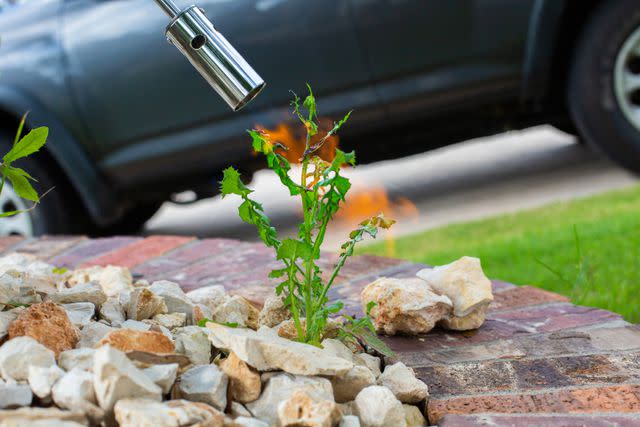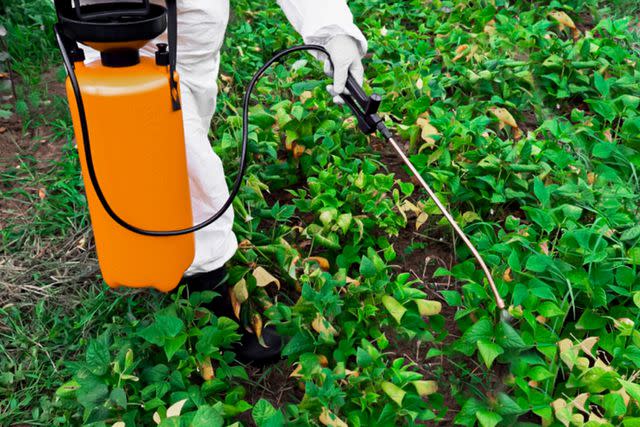10 Effective Ways to Kill Weeds That Are Guaranteed to Work
:max_bytes(150000):strip_icc():format(jpeg)/hoe-in-use-big-579391f63df78c173496eedc.jpg)
Many types of weeds plague homeowners' yards, but luckily, there are also many ways to kill weeds. Your options include both natural and chemical methods, which can both be effective. But, if you're confused about where to begin, allow us to help.
For successful weed control, it is critical for you to properly identify the different types of weeds and to understand that your approach to weed control will necessarily vary from one area of the yard to another.
Learn how to kill weeds below with 7 effective natural methods and 3 effective chemical methods to keep your landscape weed-free.
Natural Ways to Kill Weeds

The Spruce / Liz Moskowitz
There are a number of natural ways to kill weeds, ranging from preventing weed seeds from sprouting properly to applying non-chemical herbicides. Many natural methods are more applicable to weed control in vegetable gardens, flower beds, shrub plantings, etc. than to lawn areas:
Lay Landscape Fabric
Landscape fabric is a barrier that you place on top of the soil in planting beds. The idea behind it is that, if any weed seeds exist in the underlying soil, this barrier will prevent them from amounting to anything.
Once a seed germinates, its sprout needs sunlight and air to grow. But when germination occurs under landscape fabric, the sprout will simply die. Holes are made in the barrier to install plants.
Landscape fabric doesn't make sense in a bed of numerous plants, such as an annual flower display (it would require too many holes) but is ideal for shrub plantings.
Apply Natural Pre-Emergent Herbicide
Another way to kill weeds in their early stages of life is through a pre-emergent herbicide, which is used to fight weeds before they fully develop. This type of herbicide inhibits the growth of a weed's initial roots after its seed germinates.
Pull Weeds by Hand
Pulling weeds by hand is a time-honored method of killing them in the vegetable garden. Tugging on weeds, especially in loamy soil, usually results in pulling out the entire weed, roots and all. You can further facilitate matters by watering first, which loosens the soil even more.
Dig Out Weeds With Tools
When weeds are tougher to get out, or when there are so many of them that it would be tedious to pull them all by hand, use a tool to make your work easier. The traditional tool for weeding in gardens is the garden hoe, but other tools (shovels, spades, etc.) can be used in a pinch.
Weeds with a long taproot, such as dandelions, are notoriously hard to dig out. If you don't get all of the taproot out, a dandelion will grow back. If you have a lot of dandelions, consider buying a specialized tool known as a "dandelion puller."
Apply Vinegar to Weeds
Vinegar can be used as a post-emergent herbicide, although it works better on annuals than perennials. For the maximum benefit from minimal effort, do your homework first.
Observe the weeds in question to find out when they set seed. Then, you'll know when to target them to keep them from producing a new generation.
Consult the forecast to select the right day to spray—aim for a day with no rain or wind (if stray vinegar gets on your good plants, it may harm them), to be followed by a couple of days of sunshine. Rain washes off vinegar before it can do its job.
In addition, the real damage to the weeds begins in the post-spraying period: It's when sunshine strikes the foliage that the weeds die. Rather than using the vinegar in your cupboard, go to a farmers' supply store to buy the type that has a higher level of acetic acid in it.
What Are Post-Emergent and Pre-Emergent Herbicides?
A post-emergent herbicide is used to kill weeds that are already present. By contrast, a pre-emergent herbicide stops weeds from appearing in the first place by not allowing them to take root after their seeds germinate.
Pour Boiling Water on Weeds
A highly accessible post-emergent herbicide is boiling water. Pouring boiling water on weeds is one of the easiest ways to kill them, although this method works best on weeds while they are still young (older weeds get tougher and may stand up to boiling water).
Also, like vinegar, boiling water is most effective on annuals rather than perennials. Make sure you don't get any of the boiling water on your good plants.
Smother Tough Weeds With Tarps
Like laying landscape fabric, this method clearly wouldn't work for lawns (it would kill the grass). However, it can be highly effective in an area currently dominated by a tough perennial weed that you would like to turn into a planting bed.
One of the toughest and most common perennial weeds in North America is Japanese knotweed, and one of the best ways to kill it naturally is by smothering it with tarps.
If you have a nice spot in the yard where you'd like to plant flowers but which is currently occupied by a thick stand of Japanese knotweed or a similar perennial weed, laying a tarp over it until the weed dies could be the answer to reclaiming the area.
Chemical Ways to Kill Weeds

The Spruce / K. Dave
If you're not interested in staying organic, there are many chemical options for killing weeds. What the best weed killer is for you depends on factors such as the types of weeds you're trying to kill and the area of the yard where you have the weed problem:
Apply Weed and Feed With Pre-Emergent on the Lawn
There are chemical equivalents to corn gluten, the pre-emergent herbicide used to kill lawn weeds before they have a chance to take root. Weed and feed fertilizers sometimes contain a chemical pre-emergent herbicide, making them perfect for application in spring.
While fertilizing your lawn, you can simultaneously suppress weeds that would soon emerge and cause problems.
Apply a Selective Post-Emergent on the Lawn
A selective herbicide is designed to kill only specific plants. Using a selective lawn herbicide compatible with your type of grass allows you to kill certain weeds on the lawn without also killing the lawn.
By contrast, non-selective herbicides will kill anything and are more useful in other landscape areas rather than on lawns. The pre-emergent herbicide in the weed and feed you applied in spring may not have prevented all weeds from emerging in your lawn during the growing season. At some point in the summer, you may want to apply a selective post-emergent herbicide on the lawn.
Wear Protective Gear
When handling and using chemical herbicides, wear suitable protective gear such as: goggles, gloves, long plants, long-sleeved shirts.
Apply a Non-Selective Herbicide to Planting Beds
While we generally avoid using non-selective herbicides on the lawn for fear of harming the grass, they can be useful for killing weeds in planting beds. Even there, however, you must be careful. The most popular non-selective herbicide is glyphosate.
If you are clearing an area of weeds to create a planting bed, you can spray with glyphosate without fear of killing good plants. But in an existing planting bed, be careful in applying a non-selective herbicide. If you choose to spray, do so on a day that is not windy.
To better control delivery of the product to weed foliage, instead of spraying, try painting the herbicide on with a brush or using an herbicide injection tool. These more controlled approaches may not be feasible, however, if a large area must be covered.
Frequently Asked Questions
What is the strongest thing to kill weeds?
Glyphosate is considered as strong a chemical herbicide as you can widely find on the market at the present time.
What homemade herbicide kills weeds permanently?
Of the homemade herbicides, boiling water is the easiest to make and the most effective.
Does vinegar kill weeds permanently?
If properly applied, vinegar will kill annual weeds permanently.
Read the original article on The Spruce.

